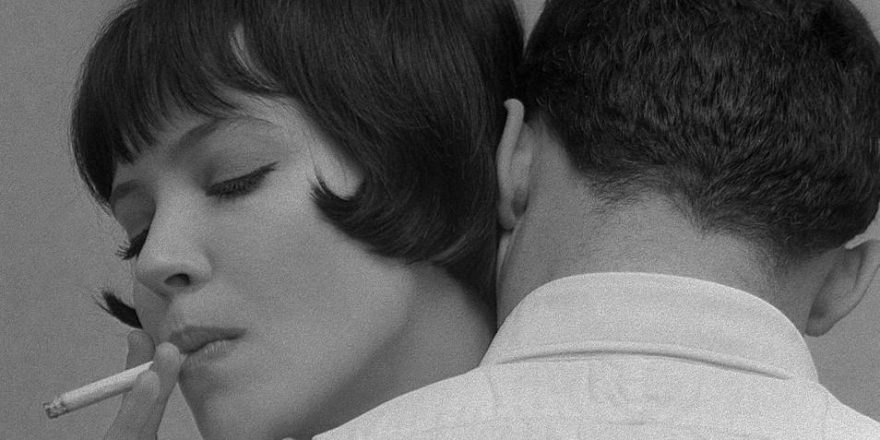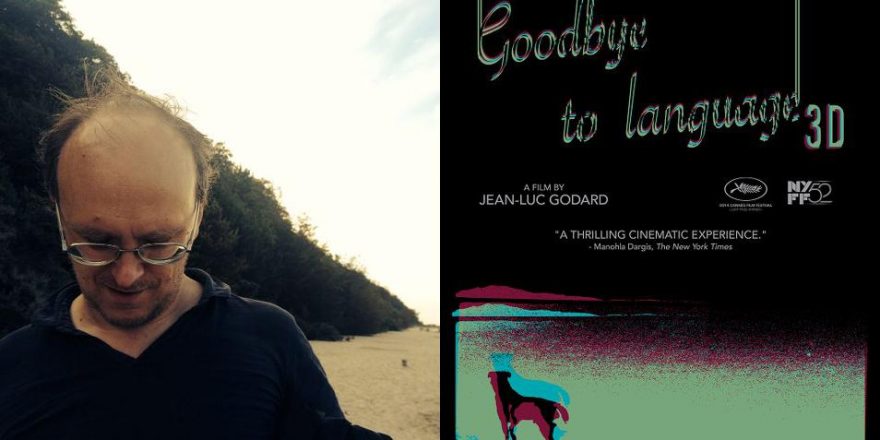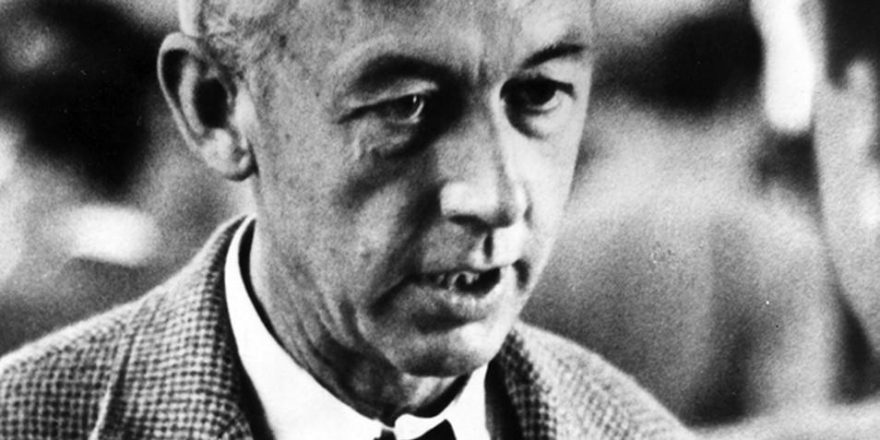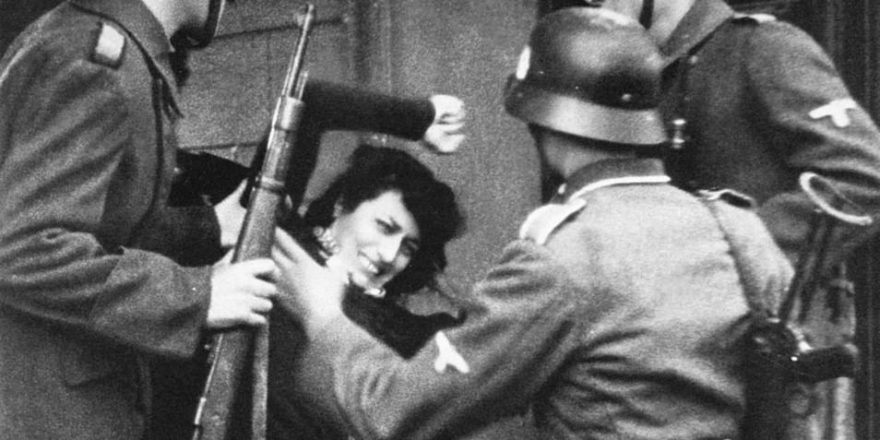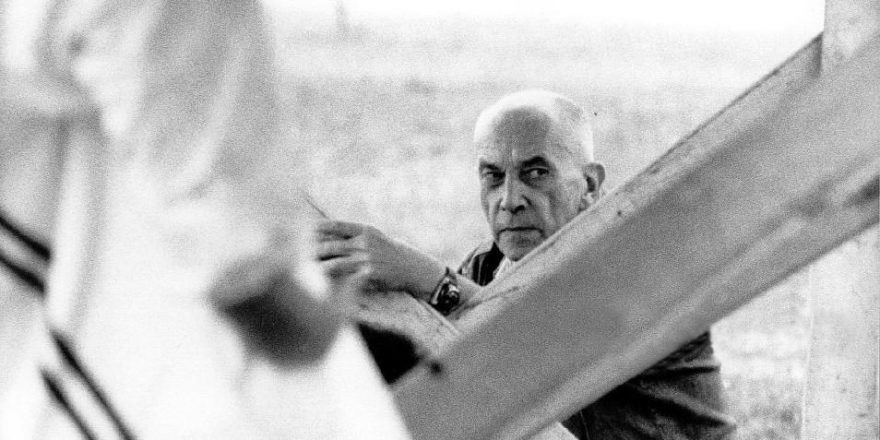Somehow I missed Goodbye to Language when it came out last year, and that blunder haunted me for months afterwards. To make up to Godard for not seeing his 3D masterwork, I sat down to watch Vivre Sa Vie. Over the years I’d told countless people, “It’s my favorite Godard film!” (usually in an assertive, proclaiming voice), and the echo of those words was now taunting me. Was it still true? I realized I had no idea and hadn’t actually watched the film in years. The fact for some reason shocked and appalled me.
My priorities in hand, I sat down and gave Vivre Sa Vie my undivided attention. Twenty minutes in, however, I was fidgeting. I was annoyed at the film for being black-and-white and annoyed at it for being slow – things I used to love about it. And yet within my mounting disappointment (in myself), I registered the fact that I couldn’t actually take my eyes off the movie, nor did I have to fight the itch to turn it off. Because as one shot followed the next, a rhythm compelled me, boredom and all, to stay engaged. At the halfway point, I felt like I would go anywhere with this film – and I feel, in fact, as though I did. Anywhere in the heart’s ruminations or the mind’s drifting, there was a gravity to return to, a diving board to leap off from. And the end was wrenching – as though I had no idea what was coming. I did know. I remembered the film very well and that took nothing away from it. Staggered, I stared at the menu, then glanced back at my life. In that quiet empty space then came the rush that every true film provokes, that only film has the capacity to provoke: a kind of rebirth or re-entry into the senses. Do you feel that, or am I alone in this?
When I walk out of a movie theater and down the hall to the exit, I am alive – I feel with a distinctly new acuteness of energy in my senses all the tactile experiences that make my life immediate and fragile. I have this sensation when movies are mastered by authors in command of their own rhythms. That command is the quality you cannot quite put your finger on, but that compels you – or rather, compels something in you – to tune in to a deeper level of your consciousness and to give over that part of consciousness to the experience in front of you. At the end of said experience, you are returned to yourself with a new energy behind your eyes with which to devour your world.
You need not be bludgeoned over the head Birdman-style to have an experience in a movie theater.Godard is living proof that if you have balls, you don’t need a plot or a genre. A woman in a café, whose face you can’t quite see, is negotiating her relationship with a man you can’t quite see. Plot: nil. Engagement: total. Pretention: depends on your taste, I guess. (For me, every movie is a trick or gag of some sort, and placing the camera behind the actors for three full minutes, denying us their faces, is just another way of having fun with the audience, of doling out the “story” – and it is precisely “tricks” like these that make plot and genre unnecessary.) A close-up of Nana’s face as music swells, then conspicuously disappears, then swells again. What is this? Another way to experience what we have come to know as the fundamental route to empathy with a character – stare at her face. We overuse it in movies all the time; but here’s another way to use the close-up, and one that pushes much further in its demands from you – as though with a swell of the music, you are being asked, “So, what do you feel now?” And when the music lapses into silence, “How ’bout now?” Godard is constantly testing and re-testing your emotional sphere and catching your gut instincts off guard. Who needs plot when there’s all this calculated, meditative attention being devoted to where you, as the audience, really are in relationship to the film.
When a film takes these pains, the result is what I would call a heightened cinematic experience; it ventures far beyond plot, talking heads and pretty (or sad) resolutions. This form of filmmaking beckons you to a place that is closer to the way your heart and mind actually work – the cyclical, patterned nature of thought, the fractured harmony of dreams, the daily minutia that can spawn a thousand feelings. To consider cinema first and foremost a sensory experience is something I believe modern filmmakers have largely lost touch with. I think we tend to mistake visual freneticism (Birdman) for actual sensory experience. When Godard asks for your patience that we may watch someone’s hand compose a letter and wait for the words to appear, he does not do this in the spirit of torture: he observes life and asks you to do so, with the added dimension that by bearing witness to an action (simple!), you are taking part in its tiny drama. And one action (one shot or sequence) leads to the next, and you only slowly realize you are being swept up in an experience that is emotional, tactile, and a touch surreal, moment-by-moment, just as life is.
You need not be bludgeoned over the head Birdman-style to have an experience in a movie theater. (Unless your starting point is zero-consciousness and you literally need to be woken up.) Birdman is that loud guy at the bar who is charming for a few minutes, and who one then realizes is basically saying, “Me me me me me,” at the top of his voice. Vivre Sa Vie, to pursue the metaphor, is the person at the bar who is an actual human being – yes, with filters, masks and tricks, but also with a genuine need to reach out for contact. She has a sincerity of expression that is open – that invites you to bring yourself to the table of the experience – and is not so overflowing with bombast that she is incapable of listening to you. On the contrary, barfellow Vivre Sa Vie is paying attention to you, to your experience, and this is why you can get carried away by her.
Godard is a “master” because he labors to master his own rhythm. This is the scary thing that an artist is called upon to attempt. Vivre Sa Vie is deeply personal without being egocentrically autobiographical – it is an author sharing the way he experiences life. Plot is sublimated to the uninflected capturing of that experience. And it is with this effort that a filmmaker empowers you to have your own experience. In this articulation of images, a language is discovered – not preconceived – between the author and the audience, in the moment of consumption. That’s why it feels utterly momentous when you watch Vivre Sa Vie, a tiny little film about a young woman living out her days on the streets of Paris. Because it is not the inherent or supposed importance of the subject matter (plot, ugh) that matters at all to the experience of a movie, really. It is the connection that you have, in a vital sense, to the sequence of images before you. Here you have taken part in making that journey what it was. It means the author has to leave things undone – there have to be patches of silence, empty spaces (something a plot-driven film can never provide, by definition) without which there is literally no room for the you who is watching to participate. I utterly remembered myself while watching Vivre Sa Vie. I felt the jolt that made me love movies in the first place. I would call that jolt “I am alive and I am not alone” – and that jolt, to me at least, is the mark of a real film.


